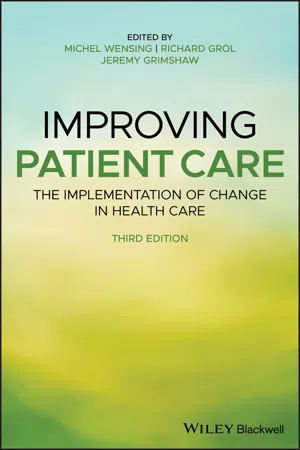
Improving Patient Care
The Implementation of Change in Health Care
- English
- ePUB (mobile friendly)
- Available on iOS & Android
Improving Patient Care
The Implementation of Change in Health Care
About this book
Strategies for successfully updating and improving health care organizations of all kinds
Health care is always evolving and improving. However, the rapid speed of medical advancement can make the adoption of new technologies and practices a challenging process – particularly in large organizations and complex networks. Any projected impact upon quality and outcomes of care must be carefully evaluated so that changes may be implemented in the most efficacious and efficient manner possible.
Improving Patient Care equips professionals and policymakers with the knowledge required to successfully optimize health care practice. By integrating scientific evidence and practical experience, the text presents a cohesive and proven model for practice change and innovation, complete with analysis of innovation, target group and setting; selection and application of strategies; and evaluation of process, outcomes and costs. This new third edition also includes:
- Newly written chapters on clinical performance feedback, patient engagement, patient safety, evaluation designs, and methods for process evaluation
- Increased emphasis on the role of contextual influences in implementation and improvement
- New research examples from across the world and updated scientific literature throughout
Designed to help promote safer and more efficient, patient-centered care and better outcomes, Improving Patient Care is an essential resource for healthcare providers, quality assessors, and students of health services research, health management, and health policy.
Frequently asked questions
- Essential is ideal for learners and professionals who enjoy exploring a wide range of subjects. Access the Essential Library with 800,000+ trusted titles and best-sellers across business, personal growth, and the humanities. Includes unlimited reading time and Standard Read Aloud voice.
- Complete: Perfect for advanced learners and researchers needing full, unrestricted access. Unlock 1.4M+ books across hundreds of subjects, including academic and specialized titles. The Complete Plan also includes advanced features like Premium Read Aloud and Research Assistant.
Please note we cannot support devices running on iOS 13 and Android 7 or earlier. Learn more about using the app.
Information
Part I
Principles of the Implementation of Change
1
Implementation of Change in Healthcare: A Complex Problem
SUMMARY
- Substantial numbers of patients do not receive high‐quality care: care that is accessible, safe, effective, patient centered, well‐coordinated, and efficient.
- Changes in practice are often required to improve patient care and prevention. It may also demand changes in healthcare organizations and healthcare systems to facilitate practice changes.
- Different approaches to the implementation of change in patient care can be observed, each based on different assumptions and theories of human and organizational behavior.
- A combination of structured guidance (“top‐down”) and participation of target populations and stakeholders (“bottom‐up”) is often needed to achieve real and sustainable changes in practice.
- Different innovations and proposals for change demand different implementation strategies.
1.1 Introduction
Box 1.1 Unsafe Cardiac Surgery: The Radboud Cardiac Surgery Case
- Transparency: publicizing the data and validating them provided both the public at large and the medical center with an insight into the fact that a real problem did exist. Good objective data on performance can contribute to the sense of urgency that something really needs to be done. This information prompted the Inspectorate as well as the patients to take measures.
- National Inspectorate: the decision of the Inspectorate to close the center and to demand radical changes put the organization under great pressure to implement improvements in a quick and thorough way.
- Leadership: the new management of the department, the medical staff, and the medical center made high quality and patient safety into an absolute priority and supervised the implementation of many changes to achieve this, including, among other actions, a revised and more intensive internal audit method.
- Organization of care processes: the surgical process was redesigned with the help of all disciplines involved, daily consultation on the patients as well as a joint medical file were introduced, and cooperation with the aim of a safer surgical process became a core objective.
- Competency and motivation of professionals: less than competent or dysfunctional surge...
Table of contents
- Cover
- Table of Contents
- List of Contributors
- Introduction
- Part I: Principles of the Implementation of Change
- Part II: Guidelines and Innovations
- Part III: Assessment of Performance
- Part IV: Problem Analysis
- Part V: Strategies for Change
- Part VI: Organization and Evaluation
- Index
- End User License Agreement